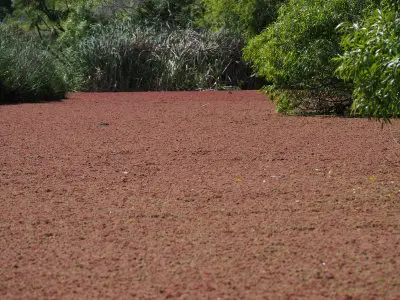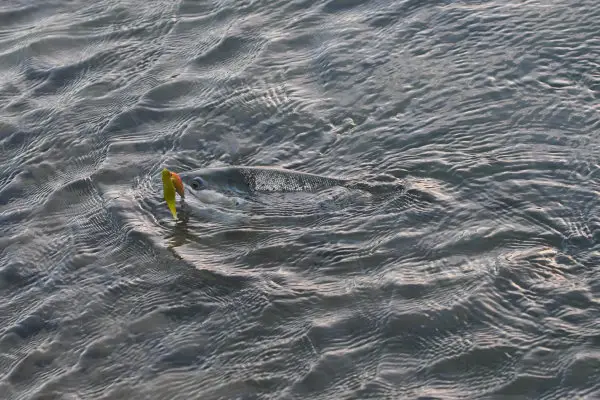You arrive at your fishing spot and started fishing, but cast after cast comes back with a lure covered in slime! This is not much fun, and removing it after every cast becomes somewhat of a chore.
So, what are some good ways to keep slime off your hooks and lures, and does a little slime scare away fish? Can you still catch trout with a trail of slime behind your lure?
How to keep slime of your hook?
There is no way to have a 100% slime free presentation, but there are a few tricks that can help reduce the amount of slime that gets caught on your hook or wrapped around your lure.
- Keep your lure terminal tackle off the bottom.
- Change treble hooks to single hooks
- Consider using weedless hooks or lures.
- Fish surface presentations
- Search for fast flowing water
- Wait until a fresh or flood cleans the river
Keep your terminal tackle off the bottom
Most slime grows close to or on the bottom. Keeping your lures or hooks a couple of feet off the bottom can greatly reduce the amount of slime it snags.
It is no secret that fish, especially trout often hold and feed close to the bottom. So there is quite a bit of skill required to work out the retrieval depth that prevents slime build up, but also goes past the most fish.
Change treble hooks to single hooks
In many ways, treble hooks are designed to catch slime, weed, or anything that is in the water. The simple act of changing from treble hooks to single hooks can greatly reduce the amount of slime caught.
Use Weedless lures and hooks
Weedless lures and hooks are specially designed to catch less weed, they also work quite well in limited the amount of slime caught.
A weedless lure, typically has the hooks buried inside the lure itself, and they only become exposed once a fish bites down on it. Weedless hooks typically have a thin piece of wire covering the hook and opening. This thin wire assists in deflecting weed and slime away from the hook. It is not perfect, but when used with the correct technique they can greatly reduce the amount of slime caught.
Fish surface presentations
Sometimes the water column is so full of slime that the only option is to fish a surface presentation. Dry flies are a great option if fly fishing, but they can also be fished with the assistance of a bobber or float when spinning.
There are also some lures that are designed to swim across the surface.
If the slime is even blooming on the surface, then the only option is to try and work your retrieve between the clumps of weeds. Easier said than done.
Fish moving water
Slime can struggle to grow in moving water, the faster the water the more likely that clumps of slime will be broken off and carried downstream.
Any slime that gets washed away usually accumulates in the pools where the current is slower, during warm summer months pools can become very difficult to fish because that is where all the slime accumulates.
Wait for a fresh
When the slime is bad, sometimes it is just not worth the effort. In such situations, it can be worth waiting until heavy rainfall sends a fresh down the river to dislodge and wash away most of the slime.
A fresh or flood can provide several weeks of cleaner bottoms and slime free lures. Makes fishing much easier.
Fish deeper water
If fishing in a lake or large pond, moving away from the shoreline to the middle of lake is a great way to escape slime.
That is because slime needs light to grow, and water does a great job at blocking that light. So fishing deeper is a great way to avoid blooms of slime.
Does slime on a hook or lure scare fish?
– Slime can dull the action of a lure
One of the main reasons why it is a good idea to remove slime from your lures and hooks is because it dulls and changes the action of your lure. A large tail of slime really slows things down and can make a lure seem lifeless. It can even stop moving parts like a spinning blade from rotating.
– Slime can hide a lures profile
Slime does not only reduce the action, it can also ruin the appearance. The pretty colors, patterns and reflections can all be hidden by a slimly greenish-brown mess. This is not attractive to the fish.
Fish get to see slime every day. So a slime covered lure is in no way attractive to fish.
– Slime can impede hooking up
A large chunk of slime wrapped around your hooks can reduce the chance of hooking up. That is because the slime can cover the hooks points, and even at times deflect the hook away from a fish’s mouth.
How to fly fish in a Didymo or slime bloom?
It was the summer of 2005 and I was fly fishing on the Clarence River in the New Zealand backcountry. This trip was the first time I encountered a large bloom of didymo or rock snot, and algae that at times can take over and start so smother otherwise pristine freestone rivers.
Every nymph I drifted, or streamer I fished can back smothered in the horrible looking brown rock snot.
In some sections of the river it was so bad, that my only option was to fish dry flies. Did make for quite a challenging trip because the majority of the trout were feeding beneath the surface.
In areas with fewer mats, I could get away with a dropper beneath a dry fly but I had to clean the snot off every few days. Okay when casting to sighted fish, but a real chore to blind fish.
How to prevent slime from catching on a fishing line?
Sometimes when the slime is bad, chunks of slime will end up snagging on and wrapping around the line itself. This is impossible to prevent entirely, and it has to be removed between casts otherwise it will cause problems getting jammed in rod guides or clogging the reel.
I can offer one piece of advice, a very thin braid can at times cut through the slime, preventing it from snagging.
Can you fish beneath algae blooms?
Not all slime forms mats or long tendrils. Sometimes the algae just float in the water column giving the water a bluish, greenish hue.
Will, while it might not look pretty. The bloom is usually only within a few feet of the surface. Due to the lack of light penetrating through the bloom the deeper water is usually much clearer.
So retrieving a lure, spinner or spoon deeper is usually a lot more productive when fishing in an algae bloom.
When trout fishing, I will also note. That algae typically bloom when temperatures are higher, and trout loving cold water will usually head to deeper water that is cooler.

Can you fish beneath Azolla (Duckweed fern)?
Azolla, more commonly known as Duckweed or mosquito fern is a small floating fern that can form large, somewhat impenetrable mats that cover the entire surface of some ponds and slow flowing creeks.
Beneath the fern, water quality is usually very good and clear. That is because the fern blocks so much light that the plants and algae beneath struggle to grow.
To answer, the question. Fishing can be very good beneath Azolla, you just need to fish a lure or bait heavy enough to break through the surface layer.

